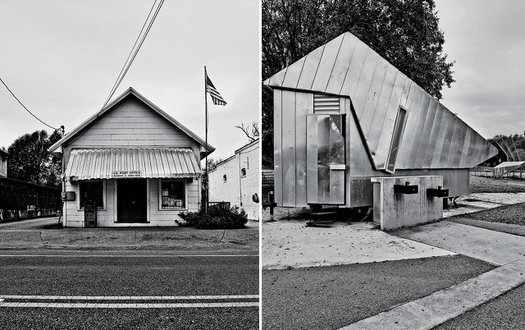
Photos by Adrian Gaut, Fast Company
The February issue of Fast Company includes my story on a subject that’s interested me for a long time: the many ambitious design and architecture projects that have played out, over 20 years, in Hale County, Alabama. It took me a long time to find the right home for this story, and a long time to report and write. (Although inevitably I ended up wishing I’d had more time — the number of enlightening conversations I had with a wide cross-section of people while working on this was astounding.)
Here is the setup paragraph for what the piece attempts to deal with:
The singular history of Hale County offers a chance to confront the most important questions that could be asked about design as catalyst. Are social designers most successful when they swoop in with the fresh thinking of outsiders? Or do they need to be embedded in the communities they aim to enhance? To use a business analogy, sometimes the rhetoric around social design suggests it can do for challenged communities what Jony Ive did for Apple. So what has really worked in Hale County? Has it improved the lives of the county's residents?
I bring this up here partly because readers of Design Observer may notice passing references to the Aspen Design Summit in 2009, and the Winterhouse Fourth Symposium on Design Education and Social Innovation, this past August 2013. I am only familiar with those (and the similar events in between) from afar, but from all I’ve read and heard about them, they embodied a holistic, thoughtful, and willing-to-be-critical approach to what's sometimes called the social design idea. And they seem premised on beliefs that while design is important, much depends on how design interacts with and learns from other fields, and also that learning from what's not working is as important as celebrating what does. In any case, I tried to operate with that spirit in this piece, albeit in a journalistic context that’s both narrower in scope and intended for an audience beyond the profession.
The story is now also online, and I’ve been getting steady feedback. Obviously I'm happy about readers who got the various things I was trying to say, and ask, with this story, and found it worthwhile.
I've also heard a bit of negative feedback — but that's been oblique, expressed privately, or both. So unfortunately there's nothing I can point (or respond) to. Suffice it to say, lots of thoughtful work has been done by lots of impressive people in Hale County, some of it successful and all of it with the best intentions. And of course I say all that in the piece. But my goal was to try to get beyond the usual three cheers — and I gather that in my attempts to answer the questions in that setup paragraph above, I may have stepped on some toes, and perhaps lost a friend or two.
At some point, though, genuine progress requires getting past the three cheers, and asking harder questions. At least that's what I think. Maybe you'll have a different take. The story is here.
